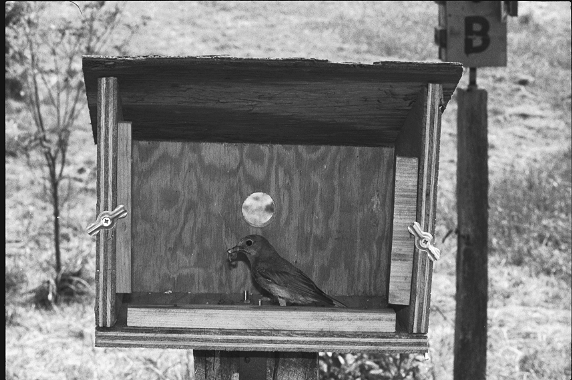
| Richard & Diane Van Vleck - Personal Pages |

The bluebird is, perhaps, the most sought after and most attended to of all species in the home habitat. Millions of Americans have erected bluebird nest boxes on their property. This has exposed much of the day to day life of the bluebird to the scrutiny of these human benefactors. They quickly learn that the backyard nest boxes they have provided are not an absolute safe haven for the bluebird family. Predators, from raccoons to black snakes to chipmunks, destroy eggs and young, if given a chance. The second stage of bluebird hosting is, then, to modify, relocate, or replace the boxes or posts, or to buy one of the many predator guards offered in seed stores and in the back of birding magazines.
Next, the more careful observer may notice the larvae of blowflies in the nest box. These larvae feed on the nestlings at night and hide in the nesting material during the day, thus avoiding being eaten by the adult bluebirds. Heavy infestations can be life threatening to the nestlings, but, a few larvae do no noticeable damage. If larvae are numerous and the nestlings appear weakened, the conscientious bluebirder removes the young and replaces the nesting material with dried grass, packed and cupped to the shape of the original nest.
Although predation, and, to a lesser extent, parasitism, do take their toll of nestling bluebirds, perhaps a greater and often overlooked threat is the weather. Cold, rainy weather in early May can spell disaster for the first brood. The adults will, of course, nest again, but, there are important advantages to having a successful first brood. This early brood is more likely to escape the treachery of the house wren, who nests later in the season. Subsequent broods of bluebirds are often destroyed by the male wren. Also, the young of the first brood often help to feed later broods, a decided advantage that is lost if the first brood is allowed to perish. It is not so much the exposure to cold wet weather that harms bluebird nestlings, as it is the scarcity of insects caused by such weather. With plenty of food, nestlings can survive even the freak May snow storm. Insects can also become scarce during a prolonged summer drought and heat wave. When berries are dried on the vine and succulent varieties of insects virtually disappear, the future of nestling bluebirds dims considerably. During such extreme weather conditions, offering the adults a supply of mealworms or other insects and small chunks of fruit or grapes can greatly increase the chances of nestling survival. I prefer mealworms because they are both easily reared and easily fed to the bluebirds.
A simple bluebird feeder consists of a stake driven into the ground near the nest box, with a jar lid nailed to the top. Punch holes in the lid to allow rain water to drain. The mealworms will not crawl out of the shallow lid or dry out in the sun simply because they won't have time. Once you drop the mealworms in the lid and turn to walk away, they will have a life expectancy of about five seconds. For feeding larger amounts of worms, and to exclude other species of birds, a feeder box should be constructed with a 1½" entrance hole. I use a removable glass front to allow viewing the birds and to discourage house sparrows from attempting to nest in the feeder.
Mealworms can be reared on a variety of food sources, including dog biscuits and chick mash. I start the culture about two months before it will be needed with several dozen mealworms. During a prolonged summer drought, many worms may be needed, but, the sudden spring cold spell may last only two or three days. Then it may be more practical to just buy the meal worms when needed from your local bait shop. Offering a steady diet of mealworms to a nesting pair is not recommended.
2009 update The above was written 18 years ago and its been that long since I have felt the need to feed bluebirds or other species. We have instead restored habitat to provide plenty of natural food year round. The bluebirds on our 17 acres are more abundant than ever.
| barn owl | American kestrel | purple martin | barn swallow | Eastern bluebird |
| tufted titmouse | Eastern phoebe | yellow shafted flicker | tree swallow | chimney swift |
| house wren | big brown bat | Carolina wren | brown thrasher | catbird |
| Eastern wood-pewee | cedar waxwing | Northern mockingbird | Turkey vulture | |